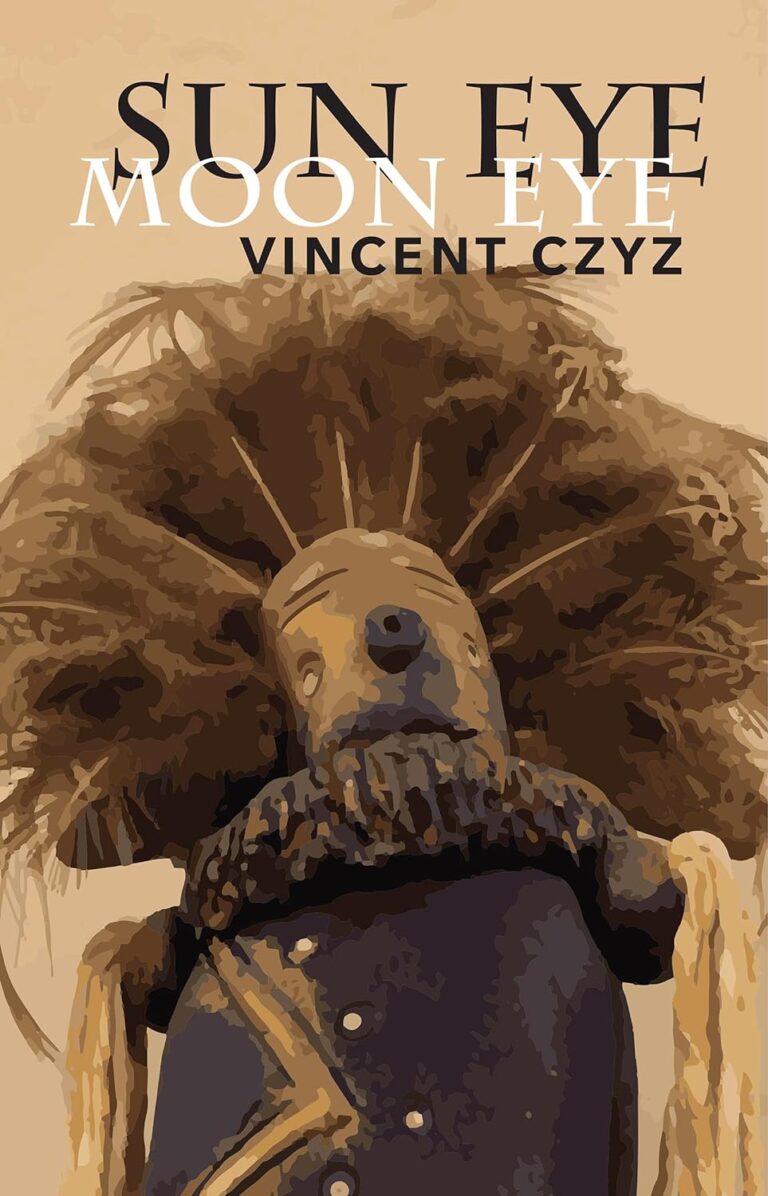Everything about the life of Logan Blackfeather, the protagonist of SUN EYE MOON EYE, is out of sync. Logan grew up not in the Southwest of his Hopi heritage but in the flat lands of Kansas; he is half-white, half-Native; neither Hopi nor Plains; a musician who has abandoned his music; a sensitive man with violent tendencies; an under-educated intellectual raised in an abusive and emotionally-bankrupt home. Logan’s efforts to reconcile the broken puzzle-pieces of his identity make up the core of the novel’s storyline.
Despite this slender “plot,” SUN EYE MOON EYE engages and entertains, alternating rhapsodic, almost-hallucinogenic language with clean prose that grounds the reader and clarifies the action. By page three, the reader has learned the narrator’s location, that he is not from there, and that he (as well as the tone of the book) will speak with a mixture of realism and poetry.
Author Vincent Czyz smoothly navigates (for the most part) the long but fascinating internal journey of a complex protagonist who sees the world with the eyes of both an artist and a scientist. Logan observes the world around him with painfully precise details as he disappears into a smokescreen of personal obfuscation and self-sabotage. This is one elegant example: “His forehead was beginning to sag as though it were made of warm wax.” His keen observations are distanced and non-judgmental—not only offering detailed images for the reader but also speaking volumes about the emotionally cut-off, traumatized man doing the observing. Another great example: “He took the blow the way water swallowed a stone.”
The journey of discovery plays out at times like the story of a detective trying to solve a murder mystery. The ghost of Logan’s father, who died in a drunk-driving accident, appears in frustratingly obscure snatches—pressing Logan’s already tentative hold on sanity. Did he really see the ghost, or has he succumbed to madness? Logan’s father was alone in the car when he died, but Logan becomes increasingly certain that his abusive uncle-stepfather somehow murdered him.
Logan’s travels, which take place in the mid-1980s and are stuffed with references to that era’s arts and culture, cover a massive range of geography, experiences, people, and especially myths (within religions, history, origin stories, dream interpretations, and storytelling). As Czyz notes in a book blurb, “Myth and dream play key roles in reconstructing Logan’s worldview, and he begins to suspect that empirical reality is as open to interpretation as the dream world.”
The nearly 600-page book is also populated by a large cast: Logan’s doctor and fellow patients during a stint at a psychiatric hospital; friends and co-workers from construction jobs and bars; family members from his childhood; truckers he meets on long hitchhiking spells (fully-fleshed characters despite their brief appearances); inhabitants of small towns and crowded cities; members of the rarified world of artists, critics, and patrons; and the women with whom he engages. Logan especially loves Shawna, yet cannot fully connect to her—an enactment of one theme among the book’s several: “The mind can’t reach for anything without wearing a glove of preconceptions.”
Other frequent thematic motifs are katsinas (also called kachinas): the small, carved, slightly bent wooden figures that represent Hopi spiritual beings. Katsinas appear to Logan in rising smoke, in memory and dreams, in myriad representations of “Indian” culture. They pop up for sale in gift shops, as props in roadside attractions and bars, and embedded in architectural elements as bastardized imitations of icons sprinkled across the U.S. that go largely unnoticed by those without Logan’s keen observational skills.
Unfortunately, structural cracks mar the final portion of the book. A coincidence of almost impossible odds strains credibility, despite being partially tamped down by the incredulity of the characters themselves. Also, though Czyz’s language is impressively rich—layered with both visual portraiture and philosophical depth—too many rich sweets can spoil the appetite. The story reaches a flurry of climatic wordplay in the intoxicating dreamscape of an uber-wealthy art collector’s penthouse party. The event, infused with drugs, booze, and beautiful people, lasts for scores of the final 100 pages, which slide inexorably away from the controlled narrative of the previous several-hundred and toward verbal self-indulgence. The author notes in an afterword that the book is trimmed down from an earlier version, but another cut would have been welcome. Nevertheless, SUN EYE MOON EYE is still an important contribution to literature’s compendium of significant works.
Author Vincent Czyz’s SUN EYE MOON EYE proves an engaging discourse on isolation and identity with gorgeous, imagery-saturated prose.
~Anne Welsbacher for IndieReader


